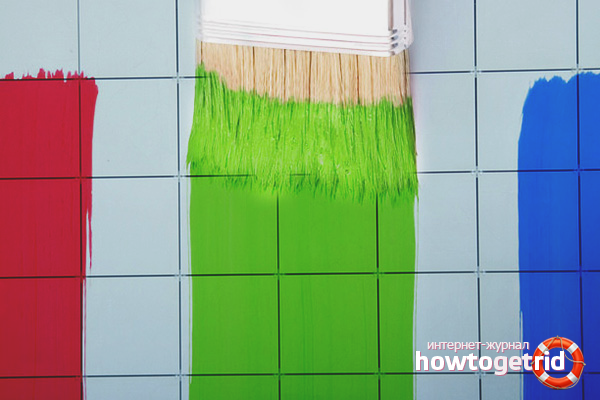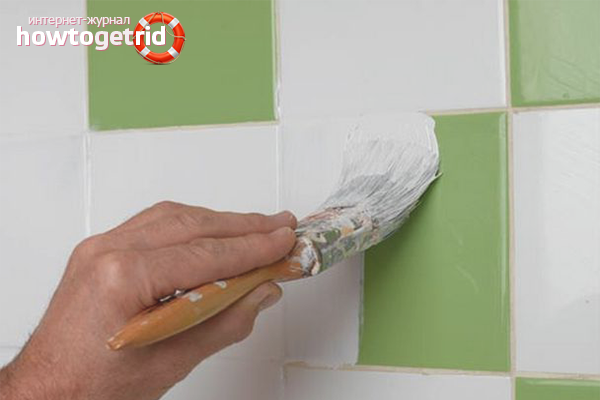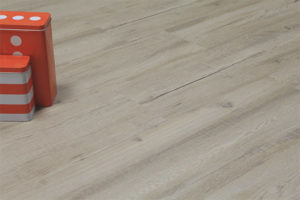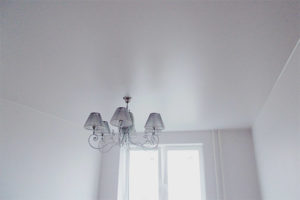The content of the article
The paint hides cracks and small chips that appeared on the tile due to high humidity or mechanical damage. It masks the darkened seams and changes the appearance of the walls in the bathroom and kitchen. Paintwork is a cheap and practical material that is used to update the design if there is no time and money to repair. It is easy to apply and remove if you know the basic rules and tricks.
Water or oil base
Redecorating a kitchen or bathroom begins with choosing the right paint. It is important to consider the specifics of the premises. Tiles regularly come in contact with moisture, heaters and grease. Not every paint will pass this test.
Acrylic varieties are among the most persistent varieties. They are bright and economical, well mask tile defects. Acrylic options withstand temperature differences, do not lose color with regular contact with moisture.
Oil-based paints fit well on the glossy and matte surface of the tile. They are evenly distributed over the walls and do not lose their original appearance for years. Oil varieties, like acrylic, are recommended for beginners to buy.
Professionals with more than one repair will love the epoxy options. Such coatings dry quickly, have virtually no smell and are designed to work in closed, unventilated rooms, like a bathtub. Epoxy paints have a thick, viscous structure, therefore, before applying the composition to the walls, it is recommended to practice on pieces of old ceramics, which it is not a pity to throw away.
Enamels have a rich color. Funds are usually released in aerosol cans, which simplify the application of the composition to the ceramic surface. Tiles before applying enamels do not need to be ground and primed. The coating lasts for years, is not afraid of high humidity and temperature changes.
After applying the paintwork to the walls or floor, fix the varnish. Oil varieties will not work, they quickly turn yellow. Water-based options are preferred. They protect the paint from abrasion, fading and do not change the shade.
If you need to update not all the walls, but only certain sections, it is recommended to buy compositions for glass or ceramics. Such paints are convenient to apply patterns and draw landscapes on the tiles. They are durable, thick and odorless. The only drawback is the high cost.
Cleaning and degreasing
Dirt and greasy stains result in bubbles and peeling paint. Walls before a small cosmetic repair must be washed. You will need:
- brush or hard sponge;
- detergent with abrasive particles or acids;
- warm water;
- rubber gloves.
The dried fat from the tile is removed with a solution of chlorine. A little product is mixed with cold water and wait until it dissolves in the liquid. The resulting composition is applied to the walls and floor, left for 10 minutes, and then clean off the remaining contaminants with an iron brush. Stains of fat are treated with a paste of soda or sprays for washing windows and mirrors.
No need to be afraid that funds will harm the tile.Cladding material will still have to be sanded before applying paint.
Wipe clean tiles with a soft cloth to remove any soapy water, and then treat them with alcohol or kerosene to degrease them. Suitable for these purposes and table vinegar or essence.
A degreasing solution is prepared quickly and easily:
- The alcohol is diluted with water in a ratio of 1 to 2.
- 300-400 ml of filtered liquid are taken per 100 ml of kerosene.
- The ratio of vinegar and water is 1 to 1.
- Part of the concentrated essence is mixed with 10 parts of water.
You can choose any recipe. In the product, a waffle towel or napkin is moistened, a rag is wrung out carefully so that it becomes slightly damp, and then the tile is wiped twice. The solution will remove the remnants of detergent and grease, prepare the tile for applying a primer and paintwork.
Work with kerosene, chlorine and vinegar essence only with rubber gloves. Wear a respirator so that toxic fumes do not enter the respiratory tract. The room after water procedures and degreasing should be ventilated, and then you can start grinding the walls.
Foundation preparation
The tiles are sanded before full painting to ensure perfect adhesion of the glossy or matte surface to the coating. Emery paper is used, which is attached to a wooden roller or spatula blade. This device is convenient to handle even corners and joints, as well as other hard-to-reach areas. Sandpaper is replaced with a sanding pad. The main thing is that the tool has small abrasive particles. Large ones damage the tile, leaving noticeable scratches that even paint cannot hide. And you just need to carefully remove the top layer of tile.
After polishing, a primer is applied to the walls in the bathroom and kitchen. Suitable product designed for non-absorbent surfaces. Ceresit CN 94 and Betocontakt Knauf are isolated. Such compositions provide adhesion of the paint to smooth and dense surfaces.
Important: There should be no silica sand in the correct primer intended for tile.
The composition is applied to the facing material with a thin layer and wait until it is completely dry. The exact time is indicated on the package.
Primer with increased adhesion is designed for oil, water-based and acrylic paints. Compositions for epoxy paints are applied under the resin-containing coating.
Dyeing
The kitchen and bathroom before repairs are freed from unnecessary furniture. If walls are to be painted, then windows, window sills and the floor are covered with plastic wrap. Plinths are sealed with masking tape so that you do not have to wipe them from stubborn spray. Film or newspapers cover furniture that could not be removed from the rooms.
The emulsion is poured into a plastic tray and diluted with water, if indicated in the instructions. A small portion of the paint is prepared, which is enough to process the entire room or 2-3 walls. When fully stained, foam rolls are used. Tools made from hard materials are recommended to be discarded.
The roller allows you to capture large sections of the wall. Use brushes if you need to apply paint to hard-to-reach areas. Choose varieties with soft and not very long bristles. Brushes come in handy when applying patterns or drawings.
A roller is not needed if auto enamel was chosen instead of acrylic and oil emulsions. But when spraying the coating, it is important to maintain the correct distance. If you get too close to the wall, ugly streaks form on the surface of the tile, which are very difficult to shade. When spraying the coating from a long distance, the paint acquires a strange matte shade that does not look too aesthetically pleasing.
The walls and seams are treated with paintwork material and left to dry for 12-14 hours. The next day, the tile is repainted.It will take a minimum of 2 layers of emulsion to hide the old color of the tile and patterns.
Tiles can not be dried with a construction or regular hairdryer. Hot air leads to the formation of bubbles and peeling of the paint material. Tools spray small particles of dirt onto the painted surface, due to which stains and stains appear that spoil the appearance of the kitchen.
They try not to use the rooms in which the tile is being updated. The stains of fat that remain on a freshly painted surface after cooking dinner, it is very difficult to wash. It is easier to remove a dry emulsion and reapply.
DIY decor
You can update the design of the bathroom and kitchen in several ways:
- draw pictures on the painted tile;
- apply patterns using stencils;
- use 2 or 3 emulsions of contrasting shades.
Stencils of flowers, animals and buildings can be found on the Internet. The pictures you like are printed on plain paper, holes are cut out in the right places and applied to the wall. A brush is carried out throughout the sheet, trying not to crawl over the edges. Carefully remove the stencil and wait until the picture dries. Walls that plan to decorate with patterns are painted with white or pastel emulsion, so that the picture clearly stands out against a neutral background.
Contrast tiles never go out of style. To decorate a room in this way, you need to cover the walls of the bathroom or kitchen with two layers of paint. After the emulsion has dried, the selected areas are sealed with masking tape, forming rhombuses, triangles or other shapes. Using a thin brush, they are stained. After 12 hours, the tape is removed.
The amateur, who first saw the roller and learned about its purpose, will be able to paint the tile. The main thing is to thoroughly wash and sand the walls, degrease and apply a high-quality emulsion. And after drying the paint, fix the result with transparent varnish, which will protect the walls from fading.
Video: how to paint a tile











Submit